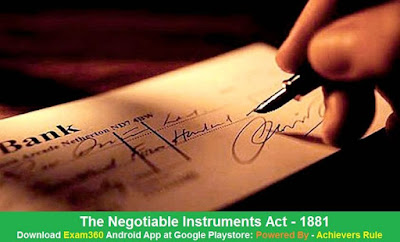
Negotiable Instruments Act, 1881 - Quick Facts
Introduction:
On 1st March, 1882 the Negotiable Instrument Act was passed during 1881 which came into force in India. It has 147 sections and 17 chapters (Section 138 to 142 were added in 1988 on 1st April, 1989 and Section 143 to 147 were added during December 2002). The Act is applicable to entire India.
Negotiable Instruments:
- The rules of Negotiable Instruments (NI) are not directly defined but according to Article 13, include an NI means and promise notes, checks payable for exchange bills and orders or buyers. As per Indian Currency Act (Section 21), a Currency Note is not a Negotiable Instrument.
Categories of Negotiable Instruments:
As per the NI Act –
- Promissory note (including certificate of deposit and commercial paper).
- Bill of exchange.
- Demand Draft (DD)
- Cheque.
Under Section 137 of Transfer of Property Act – The documents to Title to goods are negotiable which include Bill of leading, Railway Receipts, Dock warrant, GRs approved by IBA, Warehouse Receipt, and Wharfing certificate. These are also the document of title of goods under sale of Goods Act.
Assignment of Negotiable Instrument:
- Negotiable Instruments can be either negotiable under NI Act or can be assigned under Transfer of property Act by following the given producer for assignment. The procedure of assignment being complex, the parties dealing with Nis adopt, the procedure of negotiation.
What is Negotiability?
Negotiability means the transfer of the instrument to a person means the formation of the holder.
Elements of Negotiation –
More transfers without any restrictions.
Receiving materials for the transferor criteria and honesty, despite receiving any title in the title of the transferor, gets good and absolute title (called endorser).
Negotiation of Bearer Cheque (instruments) is completed by delivery (Under Section 47) and that of Order Cheque by delivery and endorsement (Under Section 48).
Types of Negotiable Instrument:
- Three types of negotiable materials by statue, cheque, exchange bill and bill of promissory notes.
- Contextual device by custom or use - Other devices have achieved the character of marketing by custom or trade use Section 137 of the Property Transfer Act 1881 also acknowledges that an instrument may be exchangeable by law or custom. Thus, the Government of India has been using Promissory Notes, Shah Jog Hundis, Delivery Order, Railway Receipts, Bill of Leading etc. or used by customs. This can be said as semi-statutory negotiable material.
Instruments payable to bearer by persons other than Central Govt. and RBI:
- Reserve Bank of India (RBI) Act 1934 (Section 31) states that in India, no person other than RBI or Central Govt. can draw, accept make or issue any bill of exchange or promissory note payable to bearer on demand. Also Section 31(2) puts a restriction on making a promissory note payable to bearer by a person other than RBI/ Central Govt.
Presumptions with regard to Negotiable Instruments:
- Section 118 provides certain presumptions as to Nis, until the contrary is proved –
- Transfer of Nis was made before maturity.
- Holder is holder in due course.
- NI, to be created, drawn, accepted, approved and transferred for discussion or consideration.
- It was passed between a date and a reasonable time before maturity.
- It was completely stamped and the stamp was cancelled, when the NI got lost.
- It bears the date on which it was made/ drawn.
- The burden of proof that the instrument is contrary to all/ any of the above presumptions, is with the person, who challenges such presumption.










Post a Comment